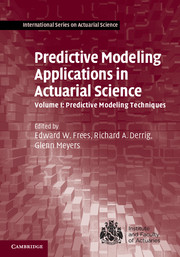Book contents
- Frontmatter
- Contents
- Contributor List
- Acknowledgments
- 1 Predictive Modeling in Actuarial Science
- II Predictive Modeling Foundations
- II Predictive Modeling Methods
- III Bayesian and Mixed Modeling
- IV Longitudinal Modeling
- 17 Time Series Analysis
- 18 Claims Triangles/Loss Reserves
- 19 Survival Models
- 20 Transition Modeling
- Index
- References
20 - Transition Modeling
from IV - Longitudinal Modeling
Published online by Cambridge University Press: 05 August 2014
- Frontmatter
- Contents
- Contributor List
- Acknowledgments
- 1 Predictive Modeling in Actuarial Science
- II Predictive Modeling Foundations
- II Predictive Modeling Methods
- III Bayesian and Mixed Modeling
- IV Longitudinal Modeling
- 17 Time Series Analysis
- 18 Claims Triangles/Loss Reserves
- 19 Survival Models
- 20 Transition Modeling
- Index
- References
Summary
Chapter Preview. This chapter provides an introduction to transition modeling. Consider a situation where an individual or entity is, at any time, in one of several states and may from time to time move from one state to another. The state may, for example, indicate the health status of an individual, the status of an individual under the terms of an insurance policy, or even the “state” of the economy. The changes of state are called transitions. There is often uncertainty associated with how much time will be spent in each state and which state will be entered on each transition. This uncertainty can be modeled using a multistate stochastic model. Such a model may be described in terms of the rates of transition from one state to another. Transition modeling involves the estimation of these rates from data.
Actuaries often work with contracts involving several states and financial implications associated with presence in a state or transition between states. A life insurance policy is a simple example. A multistate stochastic model provides a valuable tool to help the actuary analyze the cash flow structure of a given contract. Transition modeling is essential to the creation of this tool.
This chapter is intended for practitioners, actuaries, or analysts who are faced with a multistate setup and need to estimate the rates of transition from available data. The assumed knowledge – only basic probability and statistics as well as life contingencies – is minimal.
- Type
- Chapter
- Information
- Predictive Modeling Applications in Actuarial Science , pp. 515 - 538Publisher: Cambridge University PressPrint publication year: 2014

